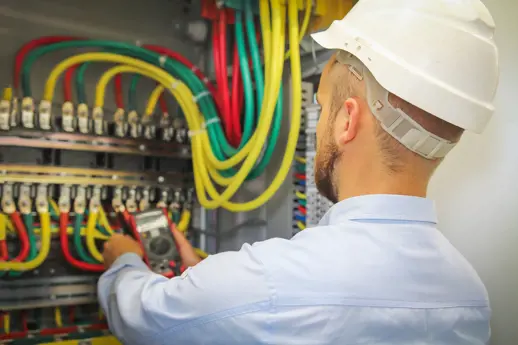
Guide to medium and high voltage motors
Electric motors are pivotal in powering industries worldwide, from manufacturing lines to renewable energy farms. At the heart of these motors is a concept known as "voltage," a fundamental electrical parameter that determines the power and efficiency of these machines.
Understanding voltage is crucial for selecting the right motor for any application, ensuring that it meets both the operational demands and energy efficiency requirements of your industry.
At Hoyer, we specialise in delivering motor solutions that are precisely tailored to our customers' needs across various sectors. Our expertise in medium and high voltage motors equips us to address the specific challenges faced by industries, offering solutions that enhance performance whilst promoting energy conservation.
This guide aims to demystify voltage, offering insights into its role in electric motors and guiding you through the selection process for the optimal motor voltage level.
Downloade our guide
In this guide we provide everything you need to know about medium and high voltage motors. Enter your name and email address and access the guide.
What is voltage and why does it matter?
Voltage, in its essence, is the driving force that pushes electric current through a circuit. It's what powers our appliances, lights our buildings, and runs industrial motors. The importance of understanding voltage lies in its impact on an electric motor's performance and efficiency.
The impact of voltage on electric motors
Voltage significantly influences the performance, efficiency, and suitability of electric motors for specific applications. Motors designed to operate on low voltage electrical systems are typically found in residential and light commercial applications, offering simplicity and safety for everyday uses.
On the other hand, medium voltage motors are suited for applications requiring a balance between power and efficiency, such as in industrial and large-scale HVAC systems.
High voltage electrical motors, however, are reserved for the most demanding applications, including heavy industrial processes and large-scale energy projects, where their ability to deliver high power at efficient rates is unmatched.
The choice between these voltage categories impacts not just the motor's efficiency but also its durability, maintenance needs, and integration with existing systems.
Difference between low, medium, and high voltage motors
The distinction between low voltage motors, medium voltage motors, and high voltage motors is crucial in selecting the right motor for your application. Low voltage motors are often the go-to choice for applications requiring safety, reliability, and ease of use, such as in small machinery or residential applications. In contrast, medium voltage motors strike a balance between power and efficiency, making them ideal for industrial applications where both performance and energy usage are concerns.
High voltage motors stand out in scenarios demanding high power and efficiency over long distances or in large installations. These motors are preferred in industries like mining, power generation, and water treatment facilities, where their ability to operate efficiently under harsh conditions is a significant advantage.
High voltage vs Low voltage:
- High voltage vs medium voltage motors are capable of delivering more power efficiently over longer distances, making them suitable for heavy industrial applications, whereas medium voltage motors are preferred for safer, less intensive applications where a high power is still needed.
- Medium voltage vs low voltage: Low voltage motors are best for applications with minimal space and lower power requirements, while medium voltage motors offer a middle ground with better efficiency and power for industrial applications without the extensive infrastructure high voltage systems require.
Choosing the right voltage for your needs
Selecting the correct voltage for an electric motor involves several considerations, including application requirements, energy efficiency, and operational cost. Here are some aspects to consider:
- Application Requirements: Understand the power and performance needs of your application. High voltage motors might be overkill for light applications, whereas low voltage motors may not suffice for industrial needs.
- Energy Efficiency: Higher voltage motors often provide better efficiency at higher power levels, important for reducing operational costs in energy-intensive industries. It may also be useful to consider the difference between IE1, IE2, IE3, and IE4 when selecting an electric motor.
- Installation and Maintenance: Consider the complexity of installation and maintenance. Low and medium voltage systems might offer simpler, more cost-effective solutions.
- Safety and Regulations: Ensure compliance with local safety standards and regulations, which may dictate the use of certain voltage levels.
- Cost: While initial costs might be higher for high voltage motors and high efficiency motors such as IE4, the long-term savings on energy can offset these expenses for some applications.
Choosing the right motor voltage is critical for optimising performance, efficiency, and cost-effectiveness. At Hoyer, our expertise and broad product range ensure that we can match the right motor to your specific needs, supporting your operations with reliable, energy-efficient solutions.
